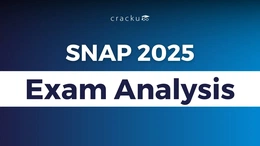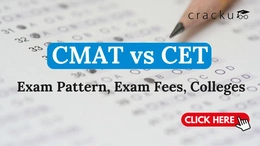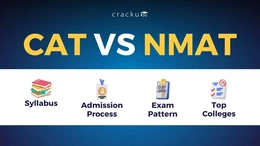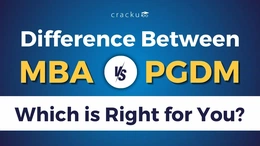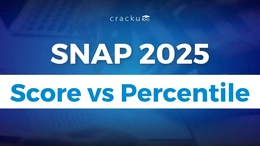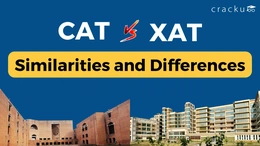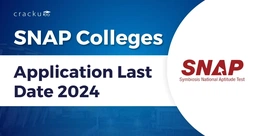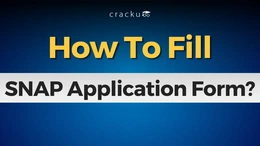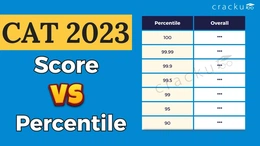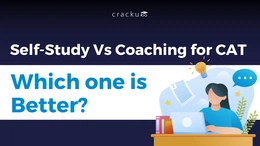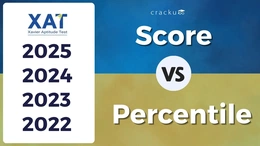When considering an MBA in India, two of the most widely recognized MBA entrance exams are the Common Admission Test (CAT) and the Symbiosis National Aptitude Test (SNAP). Both exams provide access to esteemed business schools, yet they have distinct differences.
To help aspirants make an informed choice about which exam to take, this blog provides a detailed comparison of their syllabus, difficulty levels, exam patterns, eligibility criteria, and other crucial factors to have a clearer understanding of which exam aligns better with their strengths and goals.
Difference between CAT and SNAP Exam
What is CAT?
The Common Admission Test (CAT) is India's top management entrance exam conducted every year by the Indian Institutes of Management (IIMs)to provide admission to the prestigious IIMs and over 100 other leading business schools in India. The exam evaluates aspirants in areas like mathematics, data interpretation, logical reasoning, verbal ability, and reading comprehension. Known for its tough syllabus and competitive nature, CAT requires strong academic skills, strategic thinking, time management, and lots of practice.
What is SNAP?
Symbiosis National Aptitude Test (SNAP) is an important entrance exam conducted by Symbiosis International (Deemed University) for admission into its various management programs. Known for its speed and accuracy, SNAP is designed to test candidates' abilities across 3 sections- General English, Quantitative, Data Interpretation & Data Sufficiency, and Analytical & Logical Reasoning. SNAP is required if the aspirants wants to gain a spot in one of the esteemed Symbiosis institutes.
Key Differences
Understanding the key differences between the CAT and SNAP will help candidates to make an informed choice of which exam to take and how to adjust and tailor their prep according to the exams. However, a majority of SNAP's syllabus overlaps with CAT Exam Syllabus.
| Feature | CAT | SNAP |
| Full Form | Common Admission Test | Symbiosis National Aptitude Test |
| Conducting Body | Indian Institutes of Management | Symbiosis International (Deemed University) |
| Purpose | Admission to Indian business schools (IIMs, etc.) | Admission to various Symbiosis programs |
| Test Format | Computer-based test | Computer-based test |
| Sections |
|
|
| Order of Sections | Fixed | Flexible (can attempt any section first) |
| Duration | 120 minutes | 60 minutes |
| Number of Questions | 66 (VARC: 24, DILR: 20, QA: 22) | 60 (English: 15, Reasoning: 25, Quants: 20) |
| Question type | MCQs + TITA | MCQs |
| Scoring Range | 0-198 | 0-60 |
| Negative Marking | Yes | Yes |
| Frequency | Once a year | Thrice a year |
| Test Fees | INR 2400 | INR 2250 |
| Validity of Scores | 1 year | 1 year |
CAT vs SNAP: Syllabus Comparison
While both exams test candidates on various aptitude skills they do have a slight difference in their syllabus and question types. Here is a comparison of the CAT and SNAP syllabus:
CAT VARC vs. SNAP General English
This is the verbal sections of both the exams - VARC in CAT and General English in SNAP. Both sections test candidates' skills in English language and their Verbal Reasoning and covers slightly different topics and question types.
| Exam | No. of Questions | Section Timing | Score Range |
| CAT | 24 | 40 mins | max 72 |
| SNAP | 15 | (SNAP has no sectional time limits, full paper to be completed in 60 minutes.) | max 15 |
Here is the key differences in their syllabus:
| CAT VARC Syllabus | SNAP Language Skills Syllabus |
| Reading Comprehension | Reading Comprehension |
Verbal Ability:
| Verbal Ability:
|
Verbal Reasoning:
|
CAT LRDI Vs. SNAP Analytical & Logical Reasoning
This is the analytical and critical ability sections of both the exams - LRDI in CAT and Analytical & Logical Reasoning in SNAP. While LRDI consists of both - Logical Reasoning and Data Interpretation, Analytical & Logical Reasoning in SNAP only consists of critical reasoning questions.
| Exam | No. of Questions | Section Timing | Score Range |
| CAT | 20 | 40 mins | max 60 |
| SNAP | 25 | (SNAP has no sectional time limits, full paper to be completed in 60 minutes.) | max 25 |
While Analytical puzzles remain same in both the exams, SNAP includes other topics like Blood Relations, Direction Sense, Clocks & Calendars etc. The syllabus for SNAP's reasoning section is comparatively more as compared to CAT which is highly concentrated with numeral reasoning. CAT's LRDI difficulty is higher than SNAP and includes both MCQ and TITA type questions while SNAP only tests candidates with MCQ type questions.
Here is the key differences in their syllabus:
| CAT LRDI Syllabus | SNAP Logical Reasoning Syllabus |
Logical Reasoning:
| Reasoning:
|
Data Interpretation:
|
CAT QA Vs. SNAP Quantitative, Data Interpretation & Data Sufficiency
This is the mathematical sections of both the exams - Quantitative Ability in CAT and Quantitative, Data Interpretation & Data Sufficiency in SNAP. Most of the mathematical topics are same and can be prepared together for both the exams.
| Exam | No. of Questions | Section Timing | Score Range |
| CAT | 22 | 40 mins | max 66 |
| SNAP | 20 | (SNAP has no sectional time limits, full paper to be completed in 60 minutes.) | 20 |
The major difference here is that while the CAT QA only includes Quant specific topics, this SNAP section includes Quants and Data interpretation and data sufficiency topics as a part of this section. CAT's QA difficulty is higher than SNAP and includes both MCQ and TITA type questions while SNAP only tests candidates with MCQ type questions.
Here is the key differences in their syllabus:
| CAT QA Syllabus | SNAP Quantitative Skills Syllabus |
Arithmetic:
| Quants:
|
Algebra:
| DI/DS:
|
Number Systems:
| |
Geometry:
| |
Modern Math:
|
CAT vs SNAP Difficulty level
When comparing the difficulty levels of the CAT & SNAP, it becomes clear that each exam poses unique challenges and caters to different types of test-takers. While most of the topics retain a common theme, CAT is definitely a notch difficult than SNAP as CAT requires deep knowledge and strong analytical skills, making it very challenging while SNAP is moderately difficult and less stressful. CAT's high difficulty comes from complex questions and tight time constraints, while SNAP's moderate difficulty is due to straightforward questions and the chance for multiple attempts.
Though some aspirants might feel that SNAP can be tough too as you only get 60 minutes to complete the whole paper unlike CAT where each section has 40 minutes time limit.
CAT vs SNAP Exam Pattern
The exam pattern for CAT and SNAP differs in terms of structure and time allocation as both the exams serve different type of candidates and different difficulties levels. Here is the comparison of their exam pattern.
| Particulars | CAT | SNAP |
| Total Questions | 66 | 60 |
| Total Possible Score | 198 | 60 |
| Total Sections | 3 | 3 |
| Exam Duration | 2 hours | 60 minutes |
| Question Types | MCQs + TITA | MCQ |
| Making Scheme |
|
|
CAT Exam Pattern
Here is the section wise exam pattern for CAT:
| CAT Sections | Total Questions | Time limit | Max Score |
| VARC | 24 | 40 minutes | 72 |
| DILR | 20 | 40 minutes | 60 |
| QA | 22 | 40 minutes | 66 |
| Total | 66 | 120 minutes | 198 |
SNAP Exam Pattern
Here is the section wise exam pattern for SNAP.
CAT vs SNAP Exam: Which is Better?
Deciding which exam is better for candidates can depend on various factors like choice of college, academic goals, personal strengths, and test-taking preferences etc. Here are few of the factors on the basis of which one can decide which exam is better suited for them:
- Choice of College: If a candidate's goal is to join top B-schools like IIMs, FMS, MDI-G or SPJIMR CAT should be their preferred choice as these schools only accept CAT scores. Furthermore, CAT is the most accepted exam across Indian B-schools making it the gold standard for MBA admissions. If a student wants to get admission from the prestigious Symbiosis Institute then they will have to appear for SNAP test.
- Difficulty Level: If the candidate prefers a slightly easier exam that still provides a top notch B-school admission, SNAP might be the better choice. SNAP's moderate difficulty level and comparatively easy questions is suitable for candidates who may find CAT very tough to crack.
- Flexibility and Multiple Attempts: Unlike CAT which can only be given once a year, SNAP provide 3 attempts to take the test in the same year. In this way candidates can re-attempt the SNAP test if they do not get desired score in the first time as the college will only take the best score from the attempts. Also, while CAT is a rigid test with the set order of its sections, SNAP provides the full paper at one go and allows candidates to chose whichever section they want to attempt first.
CAT vs SNAP Exam: Eligibility Criteria
Both CAT and SNAP have similar eligibility criteria regarding academic qualifications the minimum percentage requirements. Candidates should carefully check the eligibility criteria of each exam and ensure they meet all requirements.
- Both exams requires a Bachelor's degree in any discipline from a recognized university. with a minimum score of 50% aggregate marks or equivalent CGPA and 45% for the reserved category.
- Candidates who are in the final year of their Bachelor's degree or awaiting their results are eligible to apply for both the exam.
- There is no age limit set by any of these exams.
CAT vs SNAP: Preparation Tips
Effective and diligent preparation is required to crack both the exams. While most of the syllabus is same, aspirants can further tailor their preparation to suit the difficulty of CAT and to include the additional topics of SNAP.
For CAT
- CAT's VARC section features challenging reading passages and complex questions. To excel, improve reading speed and comprehension through regular practice with diverse texts and RC exercises, including verbal ability questions.
- For QA, focus on building a strong foundation in Quantitative Ability concepts and prioritize topics according to their weightage. Enhance question solving skills and speed by practicing a variety of quantitative problems regularly.
- The DILR section in CAT demands logical thinking and analytical skills. Strengthen these abilities by solving puzzles, caselets, and logical reasoning questions extensively during preparation.
- Mock tests play a crucial role in CAT Preparation, mirroring actual exam conditions. With the help of mocks you can evaluate performance, identify strengths and weaknesses, and better your time management.
For SNAP
- For General English Preparation focus on grammar, vocabulary, and reading comprehension to enhance language skills. Regular practice with grammar exercises and expanding vocabulary through consistent learning of new words is essential.
- Since SNAP tests basic arithmetic, algebra, and data interpretation like CAT, simultaneous preparation for both exams can cover a significant portion of the syllabus. However, additional focus on specific topics within Data Interpretation and Data Sufficiency is required.
- SNAP's Logical Reasoning section includes critical and logical reasoning questions, requiring dedicated practice to tackle the additional topics. Solve various types of logical problems to build proficiency.
- Aspirants can also utilize SNAP's three exam attempts to improve their scores and use the multiple attempts to showcase their best performance.
CAT vs SNAP: Marking Scheme
The marking scheme is the most important differentiation factor between both the exams. As CAT and SNAP do not have the same marking criteria.
| Marking Scheme | CAT | SNAP |
| Correct Attempt | +3 | +1 |
| Incorrect Attempt (Negative marking) | -1 | -0.25 |
| Un-attempted Questions | 0 | 0 |
CAT vs SNAP: Coaching
Many coaching centers offer integrated programs that cover preparations for both exams as part of their MBA prep packages. Enrolling in these combined courses allows aspirants to prepare for both exams simultaneously, with strategies tailored to each exam's unique syllabus and format.
Here are some of the top coaching for CAT and SNAP preparations:
- Cracku
- TIME
- IMS
- Career Launcher
- Unacademy
CAT vs SNAP: Top Colleges
Here is the list of top 10 MBA colleges accepting CAT and SNAP scores for admission into their management exam across India.
| CAT-Accepting Top Colleges | |
| IIMs | Management Development Institute (MDI), Gurgaon |
| IITs | Indian Institute of Foreign Trade (IIFT) |
| Faculty of Management Studies | Jamnalal Bajaj Institute of Management Studies (JBIMS) |
| Institute of Management Technology (IMT), Ghaziabad | T.A. Pai Management Institute (TAPMI) |
| SP Jain Institute of Management & Research (SPJIMR), Mumbai | Department of Commerce, Delhi School of Economics |
| SNAP-Accepting Top Colleges | |
| SIBM (Symbiosis Institute of Business Management), Pune | SICSR (Symbiosis Institute of Computer Studies & Research) Pune |
| SCMHRD (Symbiosis Centre for Management and Human Resource Development) Pune | SIDTM (Symbiosis Institute of Digital And Telecom Management), Pune |
| SIIB (Symbiosis Institute of International Business), Pune | SIMS (Symbiosis Institute of Management Studies), Pune |
| SIBM (Symbiosis Institute of Business Management) Bangalore | SIMC (Symbiosis Institute of Media & Communication) Pune |
| Symbiosis Institute of Operations Management (SIOM) Nashik | SCIT (Symbiosis Centre for Information Technology), Pune |




